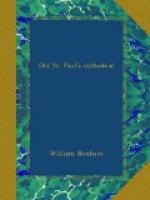As our subject is only the cathedral itself, we pass by the controversies and changes in creed and practice which the reign of Edward VI. witnessed. The Protector Somerset fell the victim of his own inordinate covetousness, and died on the scaffold, January 22nd, 1552, to the great satisfaction of the “Grey Friar” chronicler. But the Reformation went on; Bonner was imprisoned all through the reign, Ridley was made Bishop of London (1550), and the sacrament was administered according to the Reformed use. Rood-loft, altars, crucifixes, images, all disappeared. The Dean, William May, gave orders for the removal of the organ, but they were not carried out. It pealed out the Te Deum on the accession of Mary, July 6th, 1553. The nation certainly rejoiced at this change. Not merely the rapacity of the ruling powers at court had alienated public sympathy, but the people at large at this time resented the loss of their ancient worship, and had not as yet learned the greater spirituality and reality of the Reformed service. We may note that in the exuberance of popular delight in London whilst the cathedral bells were ringing, a Dutchman went to the very top of the lofty steeple, waved a flag, and kindled a blaze of torches.
But a fierce contest was inevitable. Paul’s Cross for a little while gave forth most conflicting views. Before the year was out the mass was re-established in St. Paul’s. On St. Catharine’s Day there were splendid processions and stately ceremonial, with special thought of the Queen’s mother, Catharine of Aragon. In a word, it was in St. Paul’s Cathedral that the recovery of Roman Catholicism was specially manifested in England. William May was deprived of the Deanery, he being a hearty supporter of the Reformed doctrines, and Feckenham succeeded him, but in 1556 was made Abbot of Westminster. He was so holy and kindly a man that he won great respect, though he was an uncompromising Papist. He is said to have so exerted himself with Queen Mary to procure the liberation of her sister Elizabeth as to offend the Queen, and it is further said (Fuller) that Elizabeth on her accession sent for him and offered him the Archbishopric of Canterbury if he would conform to the Reformed Faith. He refused, and was deprived, and went into retirement, and at St. Paul’s May was restored to the Deanery.




